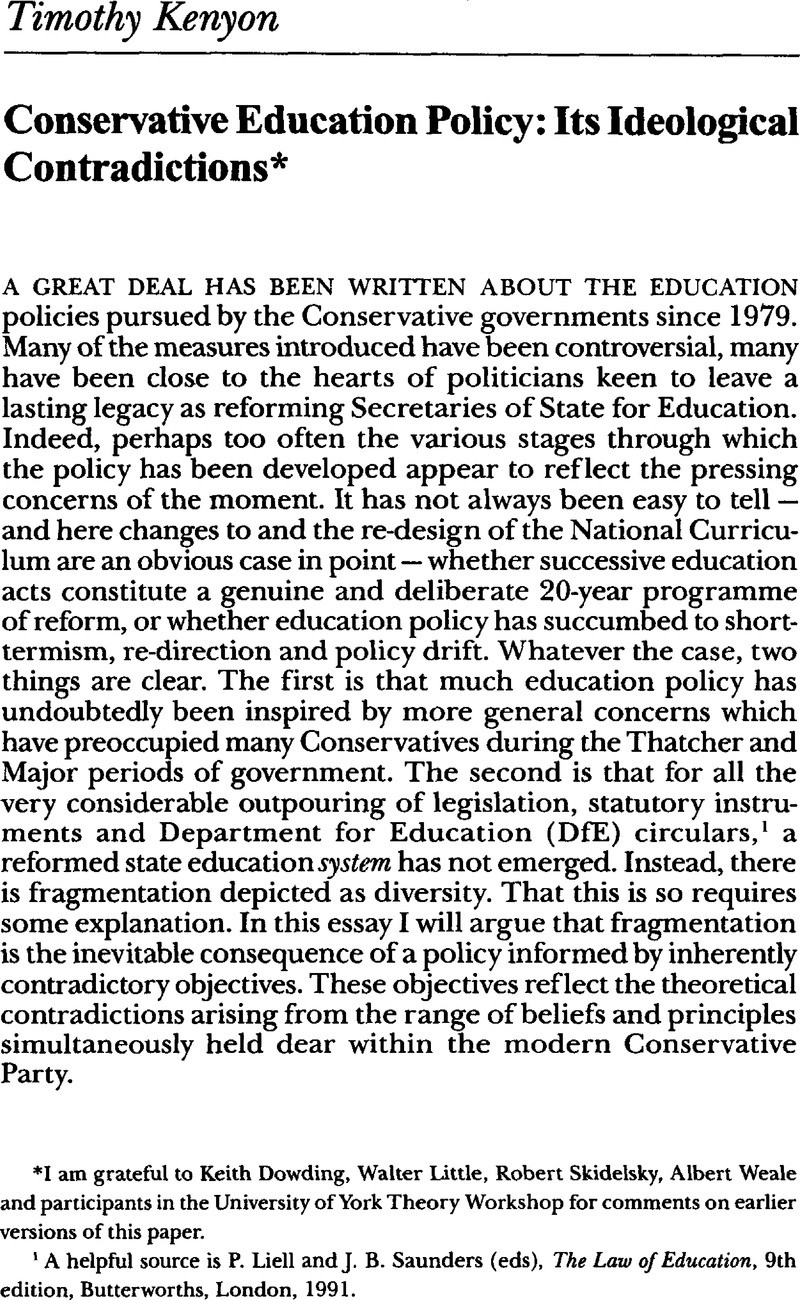Published online by Cambridge University Press: 28 March 2014

1 A helpful source is Liell, P. and Saunders, J. B. (eds), The Law of Education, 9th edition, Butterworths, London, 1991.Google Scholar
2 Of the following kind taken from a speech by the then Secretary of State for Education Kenneth Clarke to the North of England Education Conference, 4 January 1991, DES press release 2/91. With respect to general strategy Mr Clarke had this to say: ‘Education must become irreversibly dominated by the needs of pupils and their parents. It must offer a variety of provision to enable choice to be made to meet a variety of needs and preferences. Local, school and college level responsibility and accountability is the best means of providing diversity and genuine choice.’ But note what Mr Clarke went on to say about the National Curriculum: 'The programmes of study and attainment targets for each of them will be obligatory for every pupil in a quite unprecedented central Government requirement backed by Parliamentary Order.’
3 A very influential theme pursued by F. A. Hayek in The Mirage of Social Justice in Law, Legislation and Liberty, Routledge & Kegan Paul, London, 1982.
4 See Skidelsky, Robert, John Maynard Keynes: The Economist as Saviour, Macmillan, London, 1992.Google Scholar
5 Niskanen, William, Bureaucracy: Servant or Master?, Institute of Economic Affairs, London, 1977 Google Scholar, and Tullock, Gordon, The Politics of Bureaucracy, Public Affairs Press, Washington DC, 1965.Google Scholar
6 I am not concerned here with the sagacity or otherwise of decisions made by parents. Such issues are addressed by White, P., ‘The New Right and Parental Choice’, Journal of Philosophy of Education, 1988, Vol. 22, pp. 195–9.Google Scholar
7 Timothy Kenyon, ‘Choice and Diversity: The State Education Service in the Market Place’ (forthcoming).
8 Hence the issue of whether parental ‘purchasing power’ should be made explicit by, for example, the introduction of some form of voucher system linked to more ‘privatization’ — a view espoused by Robert Skidelsky, ‘The State of Education’, The Observer Magazine, 27 March 1994, pp. 34–37.
9 Choice and Diversity: A New Framework for Schools, Department for Education, HMSO Cm 2021, London, 1992.
10 For a general statement of this problem see Dowding, Keith, ‘Choice: Its Increase and its Value’, British Journal of Political Science, 1992, Vol. 22, pp. 301–314.Google Scholar
11 For a wider discussion see the work of Amartya Sen, Choice, Welfare and Measurement, Blackwell, Oxford, 1982. See also Gibbard, Alan, ‘A Pareto-Consistent Libertarian Claim’, Journal of Economic Theory, 1974, Vol. 7, pp. 388–401Google Scholar and Gardenfors, Peter, ‘Rights, Games and Choice’, Nous, 1981, Vol. 15, pp. 341–56.Google Scholar
12 Of course, matters are not quite so straightforward. The problem of’meaningful choice’ and the opportunity costs associated with choosing compound the issue. All this is succinctly illustrated by Hollis, Martin, The Cunning of Reason, Cambridge University Press, 1988, pp. 114–5.CrossRefGoogle Scholar
13 See Choice and Diversity, chapter 4, ‘The Supply of School Places’.
14 Schools, and therefore school places, are not readily divisible to meet market demand. This feature of public goods is discussed in Michael Taylor and Ward, Hugh, ‘Chickens, Whales and Lumpy Goods’, Political Studies, 1982, Vol. XXX, pp. 350–70.Google Scholar
15 Dearing, Ron, The National Curriculum and its Assessment, School Curriculum and Assessment Authority, London, 1994.Google Scholar
16 For an illustration see Smith, Adam, An Inquiry into the Nature and Causes of the Wealth of Nations, ed. Campbell, R. H. and Skinner, A. S., Oxford University Press, 1976, p. 788.Google Scholar
17 Choice and Diversity, p. 7.
18 ibid., and see also The Handbook for the Inspection of Schools, Office for Standards in Education, HMSO, London, 1993 (updated 1994), section 5.1, ‘Pupils’ spiritual, moral, social and cultural development’.
19 Choice and Diversity, p. 37.
20 The Funding Agency for Schools.
21 Some of the implications of this dilemma are explored in Brenda Almond, ‘Education and Liberty: Public Provision and Private Choice’, a paper delivered to the Morrell Conference on Toleration, University of York, 1988.
22 See Smith, Adam, op cit.; Mill, James, ‘Essay on Government’ in Lively, Jack and Rees, John (eds), Utilitarian Logic and Politics, Oxford University Press, 1978 Google Scholar, and ‘Education’, in Terence Ball (ed.), Political Writings, Cambridge University Press, 1992; Thomas Malthus, An Essay on the Principle of Population, ed. Donald Winch, Cambridge University Press, 1992, Book IV, chapter IX.
23 See, for example, Anthony O’Hear, ‘Taking Liberties’, The Times Educational Supplement, 16 January 1987.
24 See Joseph, Raz, The Morality of Freedom, Oxford, Oxford University Press, 1986, p. 58.Google Scholar